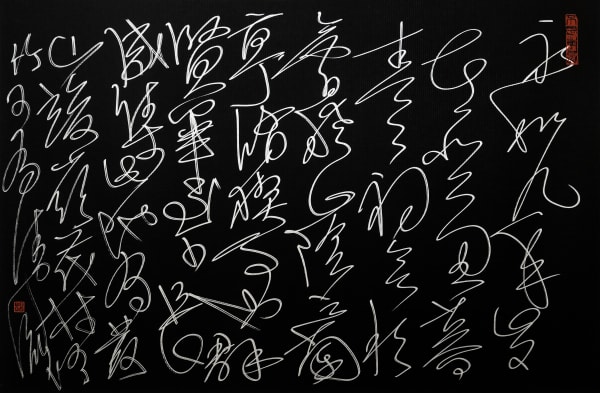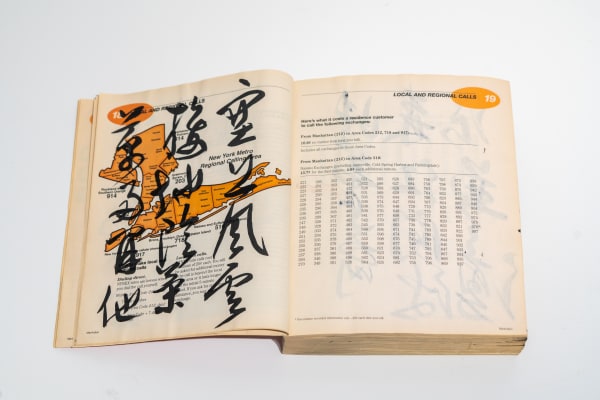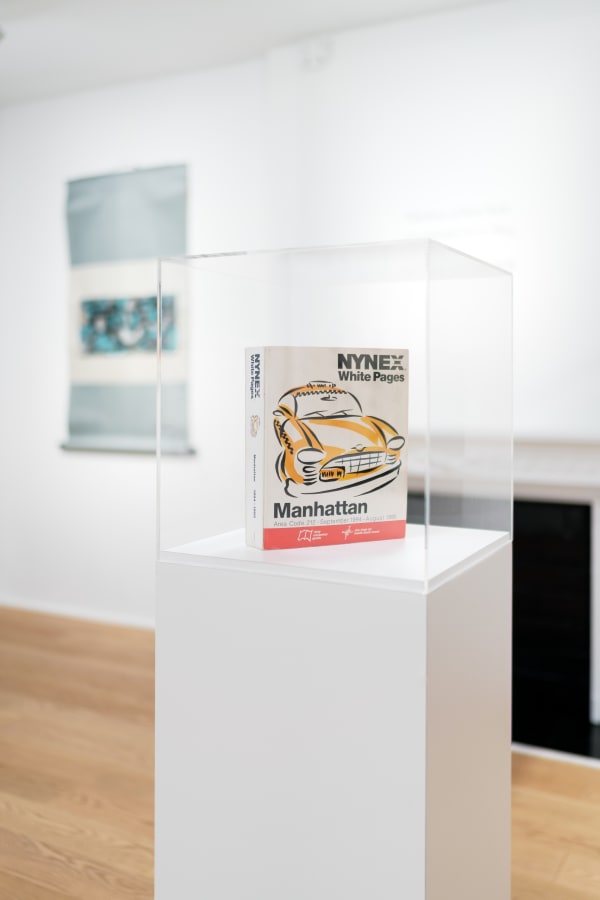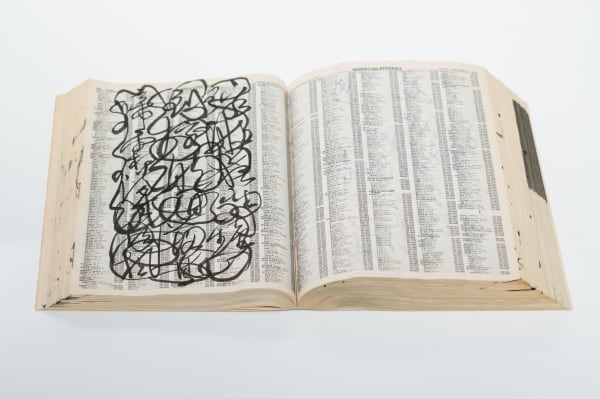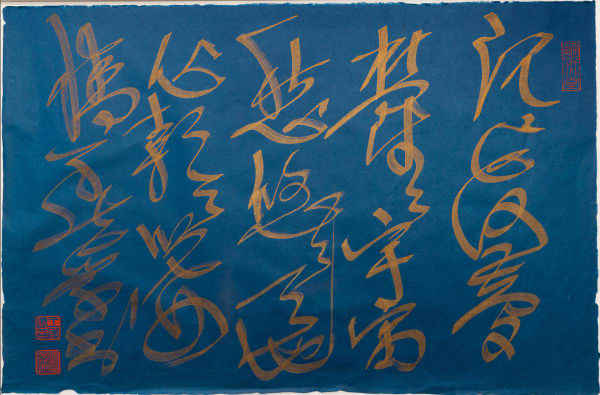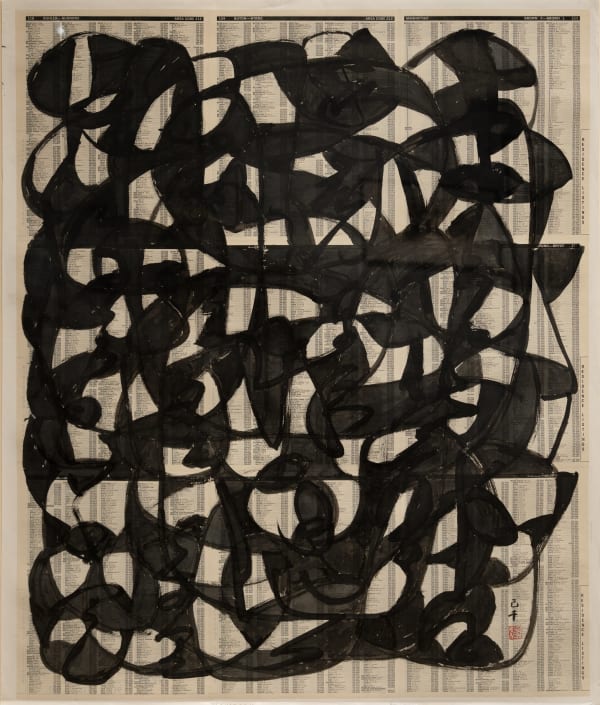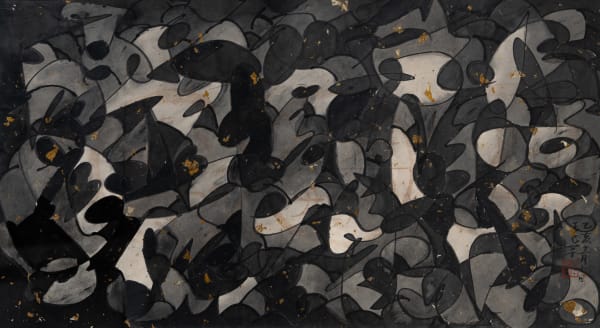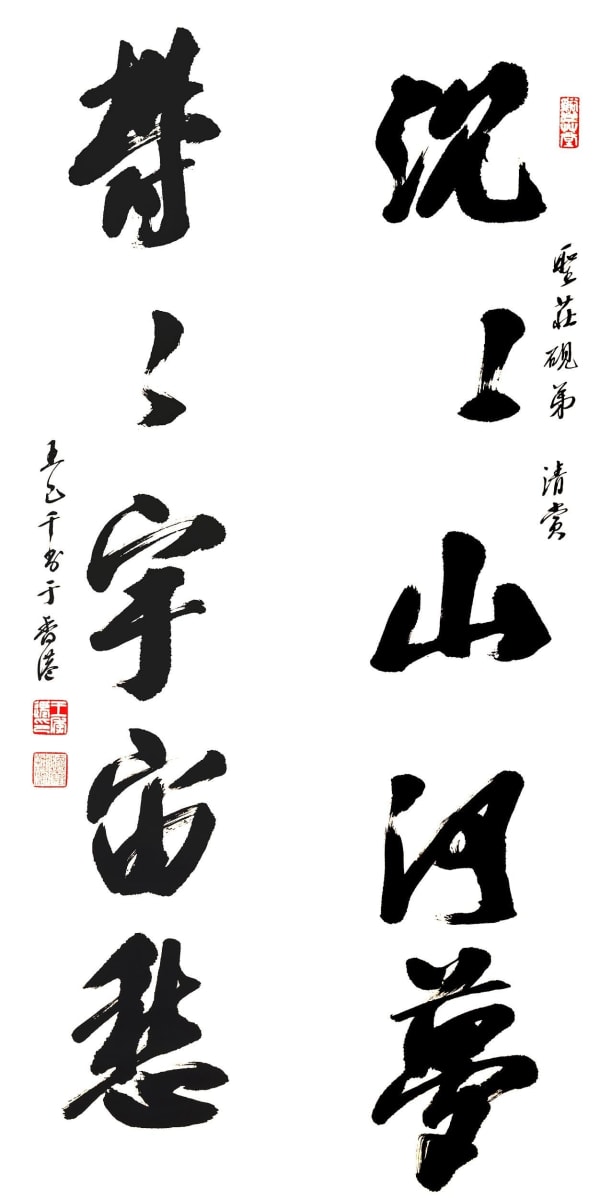-
-
-
In celebrating the coming 2022 Lunar New Year, FQM is pleased to open 'New York Rhythms: C. C. Wang's Calligraphy,' the first retrospective to focus on the artist's final two decades of calligraphy practice in New York City. In conjunction with the exhibition, FQM will publish essays by two of C. C. Wang’s former students–artist Arnold Chang and independent scholar Kathleen Yang. The exhibition will open on January 18 and continue through March, 5th, 2022. Fu Qiumeng Fine Art is located on the ground floor, at 65 East 80th Street in Manhattan, New York City. The gallery is currently open by appointment only.
The exhibit's 16 pieces, culled from the collections of a small group of Wang's friends and students, represent three significant stages of work. They chart the artist's journey from traditional calligraphy, through an experimental phase, and culminate in an abstract calligraphic period that marks his transformation from a classical Chinese landscape painter to a contemporary artist, working in tune with the 1980s and 1990s creative currents.
Wang's close association with the Art Students League of New York exposed him to Abstract Expressionism, Pop Art, Minimalism, Graffiti, and other significant twentieth-century art movements. Initially unmoved by the avant-garde work of fellow students Knox Martin (b. 1923), Robert Rauschenberg (1925-2008), and Cy Twombly (1928-2011), Wang’s early experiments with Western techniques and methods focused on using crumpled-paper pointillism and tonal washes to explore the effects of texture and chance on naturalistic landscapes. But, in the early 1980s, Wang incorporated a series of changes that revolutionized the relationship between form and meaning, transforming his works into abstract calligraphic expressions and assimilating his classical literati training with his life in New York City.
Make an Appointment
-
-

C.C.Wang (1907-2003) Blooming flowers with the Full Moon Running Script Medium: Flat Bristle brush with ink on rice paper, fan leave framed Signed Ji Qian 己千, dated kuihai sanyue 癸亥三月 1983 march Description: Blooming flowers with the full moon, enjoying longivity with auspicious as you desired. Size: 19.5 x 7.5 inch.
-
-

C.C.Wang (1907-2003)
Title:Lan Ting Xu (Preface of the Orchid Pavilion)
Cursive Script
Medium: Silver color felt marker on black construction paper, two panels framed
Signed Liaoran 了然and with five seals of the artist, dated jiaxu 甲戌 1994.
Size: 40 x 26 inch Each, 80 x 26 inch, total. 101.6 x 66 cm Each, 203.2 x 66 cm total.
-

王己千(1907-2003)
草書蘭亭序(1994年)
馬克銀筆 建築設計用紙 鏡框
尺寸:40 x 26 英寸 每幅, 共 80 x 26 英寸, 101.6 x 66 cm 每幅, 共 203.2 x 66 cm.
-
-
-
 C.C.Wang (1907-2003), Intricate Thoughts in Mind Running Script, Medium: Flat bristle brush with black ink on red construction paper, framed, Signed Ji Qian 己千 , dated jiaxu 甲戌 1994 Size:40 x 26 inch., Description: Intricate thoughts in mind, flowing fecundity in prosing.
C.C.Wang (1907-2003), Intricate Thoughts in Mind Running Script, Medium: Flat bristle brush with black ink on red construction paper, framed, Signed Ji Qian 己千 , dated jiaxu 甲戌 1994 Size:40 x 26 inch., Description: Intricate thoughts in mind, flowing fecundity in prosing.1995 marks the watershed when Wang breaks calligraphy's traditional readability as a literary text. He paints Ink and Gold Abstract Calligraphy using a traditional Chinese brush and ink on gold-flecked paper. But, embracing the aphorism that "calligraphy and painting share the same origin," his brushstrokes form abstract rather than legible shapes, and his use of monochromatic shading confounds any attempt to discover literary meaning. In Green Abstract, Wang again uses a traditional Chinese brush with ink on rice paper, but his strokes are free and bold. He reconfigures the structure and composition of the Chinese characters through random and improvisational actions and uses swathes of luminous green and moody gray to incorporate negative space as a compositional element. Finally untethered from millennia of Chinese calligraphy tradition, Wang's abstracted characters bounce across the paper like musical notes.
According to Wang, the individuality of Chinese brushwork can be considered the equivalent of western color, and he often compared the unique quality of an artist’s bimo (笔墨) or brushstroke, with the distinctive characteristics of musical rhythms.“In jazz music,” said Wang, “you don’t have to know what the singer is singing about. Good brushwork is so beautiful it can make you look at it many times, like a good voice. When you hear singing, do you expect the singing to have a good story? It doesn’t have to.”
-
-

-
-
In one of the exhibit's later works, New York City White Pages Telephone Book, Wang practices calligraphy on the pages of a discarded New York City telephone book. The calligraphy is readable, including quotes from classical poems and aphorisms memorized in the course of his classical training, but the texts bear little logical relationship to one another and thecompositional arrangements are unconventional. Invoking associations with Neo-Dada, Wang’s characters are carefully painted down individual columns and superimposed across an advertisement's smiling face and a graphic map of the 'New York Metro Regional Calling Area.’ If there is a “story” here, it is best understood in relation to his late sobriquet “Liao ran” (了然), which can be translated as “mature and intuitive.” It is the coming of age story of a diaspora artist, whose modes of communication and representation are at once local and global, and constantly shifting depending on the audience.
Another late work, Abstract Calligraphy on Telephone Book Collage, perhaps best represents Wang's integration of eastern and western aesthetics and traditional and modern practices. Wang uses a traditional Chinese brush and ink, but his medium is a collage of nine telephone book pages. His brushstrokes are again purely abstract, a mix of light and weighty calligraphic forms that throb across the printed surface. The final effect is a goal shared by eastern and western artists alike; a harmonious balance of line, color, shape, and composition.
-
C.C.Wang (1907-2003), New York City White Pages Telephone Book, Medium: ink and color on Telephone Book, signed Wang Ji Qian 王己千 on the first page, dated Wuyin, bayue 戊寅八月 August 1998. Size: L 10 ¾ x W 19 ½ x H 2
-

-
About C.C.Wang
-
“The main thing is for an artist to have Naiveté. Being Naiveté doesn’t mean being ignorant, and it doesn’t mean being incapable. Naiveté means natural. If you have the quality of being natural, that’s literati painting.” — C.C.Wang
-
-
 C. C. Wang, Lawn After the Rain Running Script
C. C. Wang, Lawn After the Rain Running Script -
 C. C. Wang, Homecoming (Gui Qu Lai Xi Ci) Cursive Script
C. C. Wang, Homecoming (Gui Qu Lai Xi Ci) Cursive Script -
 C. C. Wang, Intricate Thoughts in Mind Running Script, 1994
C. C. Wang, Intricate Thoughts in Mind Running Script, 1994 -
 C. C. Wang, Dream of the Mountain and River, Melancholy of the Cosmos Cursive Script
C. C. Wang, Dream of the Mountain and River, Melancholy of the Cosmos Cursive Script -
 C. C. Wang, Lan Ting Xu (Preface of the Orchid Pavilion) Cursive Script, 1994
C. C. Wang, Lan Ting Xu (Preface of the Orchid Pavilion) Cursive Script, 1994 -
 C.C.Wang, Lawn After the Rain in Cursive Script
C.C.Wang, Lawn After the Rain in Cursive Script -
 C. C. Wang, Lawn After the Rain in Cursive Script
C. C. Wang, Lawn After the Rain in Cursive Script -
 C. C. Wang, Abstract Calligraphy on Telephone book collage
C. C. Wang, Abstract Calligraphy on Telephone book collage -
 C. C. Wang, Lion Cliff Tiger Peaks, Crane Island, and Dragon Pond.
C. C. Wang, Lion Cliff Tiger Peaks, Crane Island, and Dragon Pond. -
 C. C. Wang, Saying Farewell to Monk Lingche in cursive script, 1990s
C. C. Wang, Saying Farewell to Monk Lingche in cursive script, 1990s -
 C. C. Wang, (Hearing the) Zither Played in Tune in cursive script
C. C. Wang, (Hearing the) Zither Played in Tune in cursive script -
 C. C. Wang, Ascending Stork Tower in Cursive Script , 1990s
C. C. Wang, Ascending Stork Tower in Cursive Script , 1990s -
 C. C. Wang, Azure Dragon Cursive Script , 1994
C. C. Wang, Azure Dragon Cursive Script , 1994 -
 C.C.Wang, Blooming flowers with the Full Moon Running Script, 1983
C.C.Wang, Blooming flowers with the Full Moon Running Script, 1983 -
 C. C. Wang, Green Abstract
C. C. Wang, Green Abstract -
 C. C. Wang, Ink and Gold Abstract Calligraphy , 1995
C. C. Wang, Ink and Gold Abstract Calligraphy , 1995 -
 C. C. Wang, Poem on couplet in Running Script , 1991
C. C. Wang, Poem on couplet in Running Script , 1991
-
C.C.Wang, 18 January - 5 March 2022
Join our mailing list
* denotes required fields
We will process the personal data you have supplied to communicate with you in accordance with our Privacy Policy. You can unsubscribe or change your preferences at any time by clicking the link in our emails.





